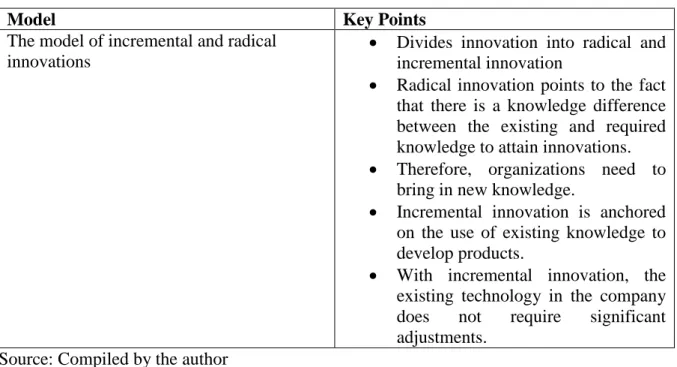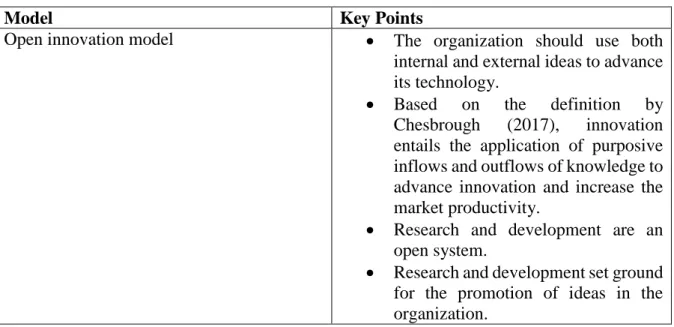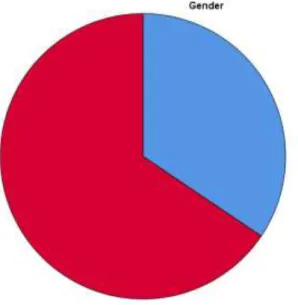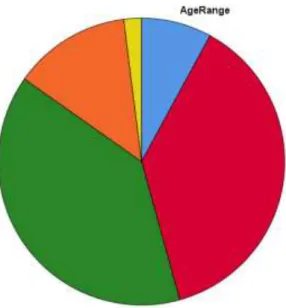This study examined the influence of middle managers' innovative self-efficacy on their innovative work behavior. Second, team leadership self-efficacy is related to middle managers' innovative work behavior.
Background of the Study
From the study by Hsiao et al. 2011), self-efficacy was related to innovativeness, with higher levels of the former translating into higher levels of the latter. As some authors such as Momeni, et al. 2014) have found that self-efficacy is crucial because it.
Statement of the Problem
Within the UAE, middle managers lack self-efficacy in part because the government ignores their input (Biygautane & Al-Yahya, 2011b). It remains unclear why the government ignores the role of middle managers when they can contribute to the achievement of its strategic objectives.
Motivation of the Study
This will help organizations to focus more on this instead of overlooking it as many of them have done. Therefore, this study will help organizations to absorb more innovation as enabled by their middle managers.
Significance and Contribution of the Study
Empirically, this study contributes to the existing literature by explaining middle manager self-efficacy and innovation in the government sector. Therefore, this study makes empirical contributions by investigating the innovative self-efficacy and innovative work behavior of middle managers in the UAE government sector.
Research Aim and Objectives
However, with self-efficacy, individuals believe in their own abilities to perform behaviors that produce specific performance achievements. Therefore, they may not have to work based on the patterns they observe in society, but their own personal drive to be innovative in the organization.
Thesis Structure
Introduction
Theoretical Background
- Social Cognitive Theory
- Theory of Planned Behavior
- The Model of Incremental and Radical Innovations
- Open Innovation Model
Miller and Dollard's (1941) theory of social learning and imitation provided the basis for the development of social cognitive theory. Social Cognitive Theory The theory was based on the social learning and imitation theory of Miller and Dollard (1941).
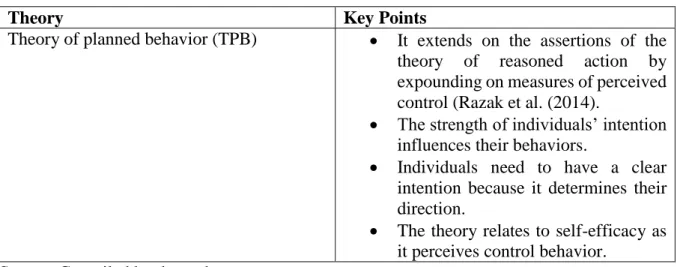
Definition of Middle Managers
The role of middle managers within an organization extends further to include being a change agent. The role of middle managers has been further expanded in the literature as providers of expertise.
Self-efficacy in the UAE and Arab region contexts
Surprisingly, according to De Waal and Frijns (2016), Arab nationals made up only 15% of the UAE population. According to De Waal and Frijns (2016), nepotism applies to the selection of top managers, but merit is applied to the recruitment of middle management.
Previous Research on Self-efficacy in the Education Sector
Further, the results showed that there was a strong relationship between teachers' self-efficacy and innovative work behavior. Based on the result, the above writers concluded that teachers who described higher levels of self-efficacy tended to demonstrate better innovation.
Previous Research on Self-efficacy in the Services Sector
In another study, Slåtten (2014) investigated the determinants and effects of employees' innovative self-efficacy in innovative activities in the service sector. 2018) investigated the effects of employees. innovative self-efficacy on innovative work behavior in the service sector.
Previous Research on Self-efficacy in the Health Sector
The independent variable in this research is the creativity and innovative self-efficacy of the middle managers. The last activity that highlights the innovative self-efficacy of middle managers in the Dubai organizations is that they retain.
Innovative Self-Efficacy ................................................ Error! Bookmark not defined
Innovation
These appear to have a much weaker impact on innovation in these organizations compared to private sector organizations. As a result, this leads to the generation of outputs that are quite difficult to determine.
Innovation within the UAE Government
The United Arab Emirates has taken several steps to promote innovation in the country. So it was important for the country, turning the UAE government into one of the most innovative public sectors in the world.
Innovative Behavior
In this case, innovative self-efficacy improves the role performance of the employees (Anggarwati & Eliyana, 2015). In the case of this study, the dependent variable is the innovation of the middle managers. Therefore, it is worth emphasizing that innovative self-efficacy in influencing employees is a predictor of the innovative work behavior of middle managers in various organizations within the UAE government.
Middle managers are always at the center of the introduction of new ideas in the organization. Essentially, the hypotheses are critical in confirming that the innovative self-efficacy of middle managers in various Dubai organizations influences their innovative work behaviors. This objective required the determination of the relationship that exists between the innovative self-efficacy in relation to using innovations and innovative work behavior of middle managers in the organization.
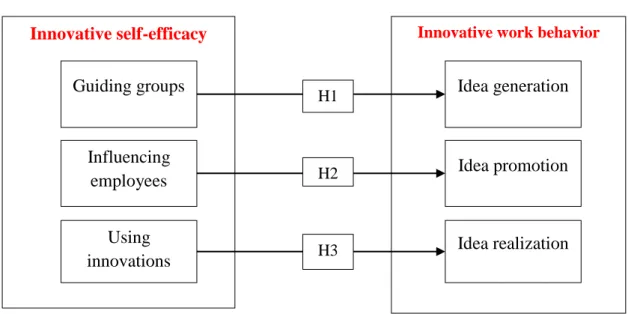
Middle Managers and Innovation
Summary
Introduction
From the review of the literature and the theoretical framework, innovative self-efficacy is perceived as a factor that influences innovative work behavior (Bandura, 1977). Anggarwati and Eliyana (2015) noted that with job satisfaction as an intervening variable, innovative self-efficacy will always lead to greater levels of innovation in the organization.
Hypothesis Development
Innovative Self-efficacy and Innovative Work behavior ....... Error! Bookmark not
Innovative Self-Efficacy towards Guiding Employees and Innovation
Innovative Self-Efficacy towards Innovations and Innovative Work Behavior
Summary
The dependent variables are the types of variables that experience manipulation by the researcher. The independent variable, in turn, is the one that has an influence on the dependent variable.
Introduction
The key difference between the two methods depends on the approaches used in data collection. According to Silverman (2011), the use of systematic processes and tools is critical in analyzing statistical data.
Variable Measurement
Innovativeness by middle managers is the dependent variable in the research for various reasons. Overall, the analysis approach is crucial in establishing the relationships between middle managers' innovative self-efficacy and their innovativeness. A final critical illustrator of the link between innovative self-efficacy in the use of innovations and innovative work behavior is the ability of middle managers to implement innovative ideas before they are implemented.
Consequently, the findings of this study showed that the middle managers in the government departments of the UAE applied their innovative self-efficacy when groups became disruptive. According to the results of the current research study, there exists a positive relationship between innovative self-efficacy to influence employees and innovative work behavior. This is an awareness that the middle managers of the organization have been able to adequately master.

Questionnaire Design and Administration
Part 2: Self-efficacy
Part 3: Innovative work behavior
The Application of the Cross-sectional Study Design
Sample and Sampling Approach
Justification for Choice of Dubai
Description of the Participants Involved in the Study
Analysis of the Quantitative Data
Reliability and Validity
The Dependent Variable
The Independent Variable
Pilot Study
Adjusted Questionnaire
Ethical Issues in the Study
Summary
Introduction
The findings were generated based on the analysis of questionnaire responses from a sample of 151 participants. In particular, descriptive statistics were applied to the findings to help understand the demographic components of the data in terms of age range, job title, company and gender of the participants.
Data Analysis
Demographic characteristics of the sample
Regarding their self-efficacy in using innovations in the organization, it was determined that middle managers can cope well with the pressure of innovative work changes. In the evaluation of the standard deviation of self-efficacy in relation to influencing employees, it was determined that the factor, "I am able to find reasons for low motivation among workers".

Factor Analysis
Factor Analysis types
As a result of the definition of the final number of the factors included in the study, the factor extraction procedure has taken place. For the purposes of factor extraction in the context of using the EFA approach, five key methods should be considered.
Factor Analysis Results
In the context of the factor analysis of the selected parameters of the study, a value of Eigenvalues was assessed for the most important parameters. The main criterion for excluding the specific factors was the extraction level below 0.3.
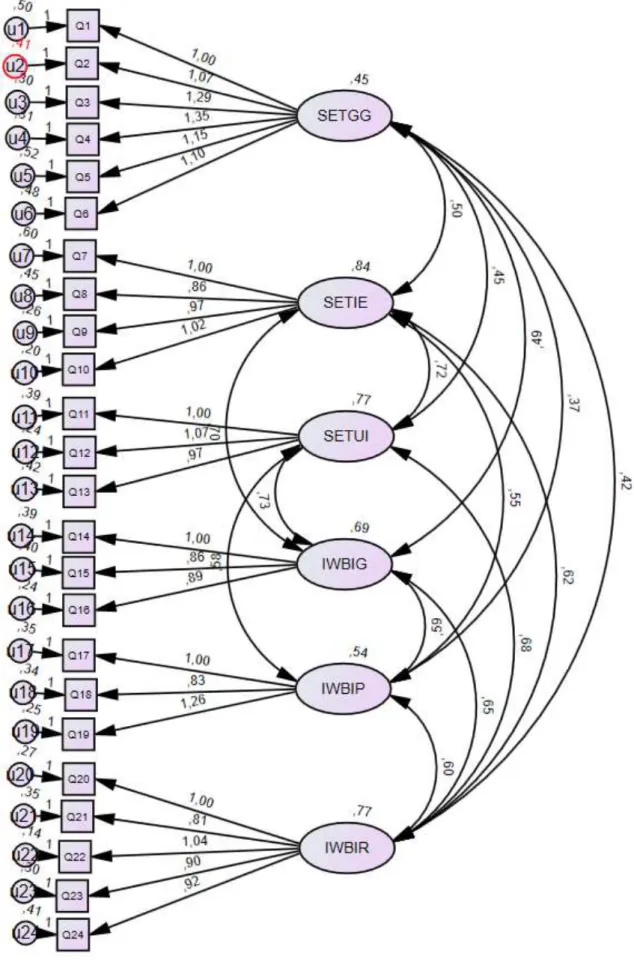
Inferential Statistics
Pearson Correlation
In line with the correlation results, there is a positive and significant correlation between innovative self-efficacy and innovative work behavior of middle managers when different constructs are correlated. For example, there is a positive and significant correlation between self-efficacy in relation to guiding groups and idea generation (.462**,p=0.000).
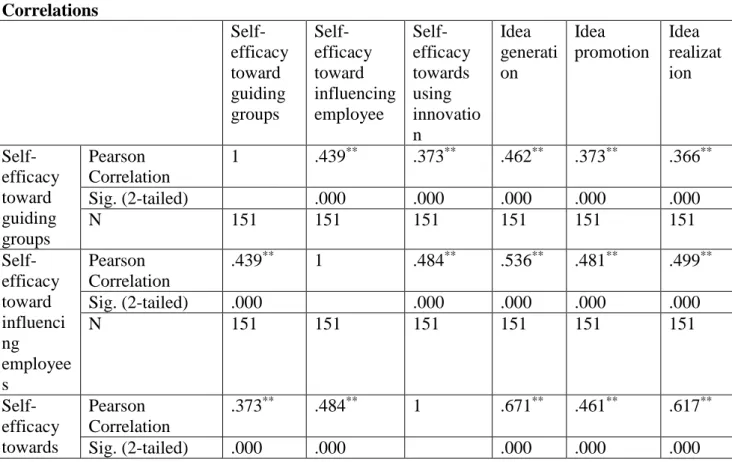
Reliability Test
Moreover, the respective items have Cronbach's alphas greater than 0.70 illustrating their internal consistency. The summarized results of the reliability test, for each item as well as the total reliability, are as demonstrated in table 5.15 below.
T-test Analysis
Regression Analysis
This suggests that innovative self-efficacy toward leadership groups has a positive relationship with innovative work behavior. Therefore, middle managers' innovative self-efficacy to use innovations is a predictor of their innovative work behavior in the organization.
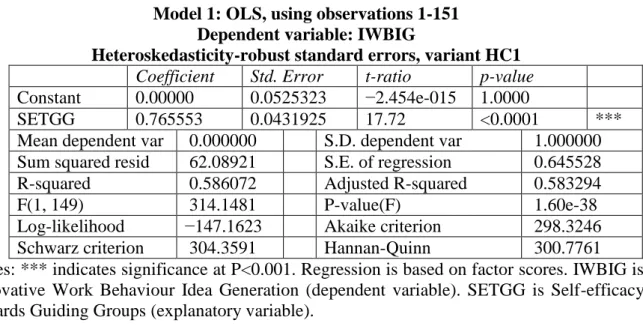
Summary of Hypotheses
To summarize the results, it was found that the innovative self-reliance of middle managers to use innovations has a positive relationship with their innovative work behavior. With greater innovative self-efficacy, there is a higher level of innovative work behavior among middle managers in Dubai.
Summary
Therefore, as innovative self-efficacy of middle managers increases, there is also an increase in the innovative work behavior. In general, middle managers in the UAE organizations have a higher level of innovative self-efficacy which consequently translates to their high innovation levels in the organization.
Introduction
Discussion
Discussion of the Results Reliability Test and T-Test
An independent sample T-Test was conducted to determine whether there was a significant difference in the means of innovative work behavior between male and female middle managers. It was found that there is no statistically significant difference in the means of innovative work behavior between male and female middle managers in the sampled Dubai companies.
Discussion of Findings Relating to the Research Questions and Hypotheses
Innovative self-efficacy in the use of innovations is positively related to the innovative work behavior of middle managers. Accordingly, middle managers with high innovative self-efficacy were confident enough to engage in idea generation.
Findings and Theory
Similarly, in the organizational environment, middle managers monitor their own innovative work behaviors that lead to better performance in the organization. In fact, Al-Hakim and Hassan (2011) found that middle managers possess valuable skills and knowledge in the fundamental areas of the organization.
Summary
Introduction
Conclusions
More so, innovative self-efficacy towards the use of innovations has a positive relationship with innovative work behavior among middle managers in the UAE. This objective was about establishing the relationship between innovative self-efficacy in guiding groups and innovative work behavior of middle managers in the UAE.
Meeting Study Objectives
Implications
Theoretical Implications
Practical Implications
Recommendations
Limitations
Future Research
Summary
